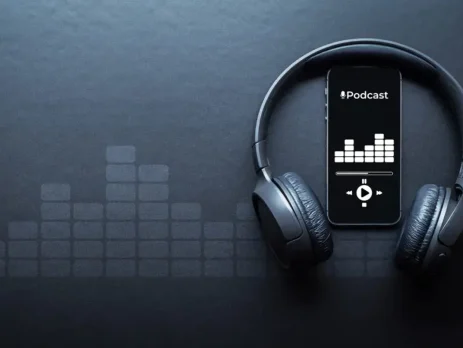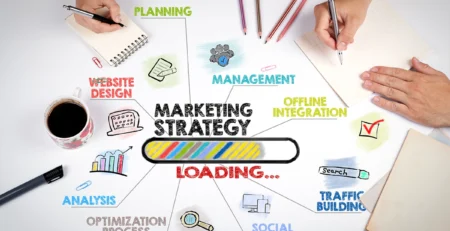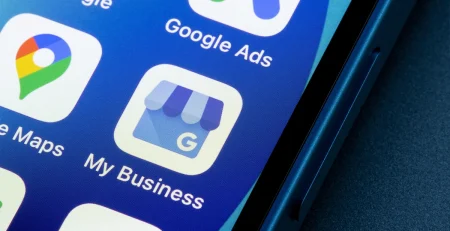Nowadays, people expect multiple types of content to suit their needs. Not everyone has time to read a 6,000-word blog post. Others want a quick video and then there’s podcasting – a great way to reach people outside of when they’re sitting in front of a computer. The best part? You don’t need to be an established content creator to learn how to start a podcast for your business.
There’s a demand for audio content and you need to cater to it.
Unlike written or visual content, podcasts are great to listen to when you’re on the treadmill at the gym, on your morning commute to work, sticking your headphones in while doing the hoover and pretty much any time a listener chooses.
Why?
It’s now easier than ever to listen to podcasts. Bluetooth technology lets people listen in their cars. Apple’s Podcast app is pre-installed on every device and it only takes a few clicks to subscribe to a podcast. It’ll also notify them each time a new episode is available to listen and download.
It’s on-demand. Just like Netflix disrupted the streaming industry, podcasting is making its own big moves.
Nothing can stop the rise of podcasts as on-demand listening has become the go-to choice for people all over the globe. With over 800,000 active podcasts and over 54 million episodes currently available worldwide, it’s clear the demand is there.
As a business, it’s time to leverage that and cater to your audience by starting a podcast. Whether you’re completely new to it or you’ve had the itch to dive in but have never really hit the green light, this guide will cover what you need to know about starting a podcast for your business.
From the software and equipment you’ll need to the long-term benefits of podcasting, continue reading to find out more.
Build a personal connection.
It’s different building a connection through written content than visual or audio. Sure, you could read all our blogs and comment on each one saying how useful they were but that ‘connection’ probably isn’t there. Mainly because all you’re doing is reading.
If I was on a podcast, I’d be able to open up to you more. You’d hear my voice every week. There would be running jokes and themes and it all builds a more personal relationship.
Do the same for yours. Open up to your viewers and listeners so you can build a relationship with them and in the long run, you’d sell more products because of how loyal they are to you.
A voice can engage an audience much better than words on a page can. That voice builds trust and it’s trust that eventually sells a product or service.
It’s convenient.
With podcasting, you don’t need to worry about your audience being so busy they can’t listen and provide value. The great thing about podcasting is listeners can download episodes and replay it whenever they choose. Jogging, driving, working, relaxing – whatever the situation, listeners can consume a podcast episode with no effort.
If listeners subscribe to your podcast feed, they can get episodes downloaded automatically on their devices whenever you release a new one. It’s much quicker than searching for a keyword online and stumbling across your blog post or finding a video they like.
It’s easy to get started.
Obviously, the more successful your podcast becomes, the more you should look to invest so the quality gets better. Although if you’re starting on the journey now, it’s fairly simple to begin. All you’ll really need is a computer, laptop or smartphone, software and a decent connection to the internet.
I’ll get into the specifics of the equipment you’ll need a little later on but the above is a good start. Press record, talk, edit and publish it on a platform of your choosing. Easy.
It’s an alternative to video.
It’s no secret that video marketing is where your focus should be. However, who’s to say everyone in your team will be comfortable to shoot videos? That can take time. The beauty of podcasting is you can create both audio and video podcasts which gives listeners an option to pick from.
If you offer an audio-only option as you see on SoundCloud, that’s fine. Some of your listeners might prefer that method. But combining both and offering your audience the option is a great way of having the best of both worlds.
Increase traffic generation.
Like any form of content, podcasting can help you reach out to new audiences for your business as it builds familiarity. Listeners tend to subscribe to a podcast they like so they can regularly listen.
As long as you’re consistent, your audience is likely to continue listening.
The knock-on effect is your loyal audience might then recommend your podcast to others. As a result, it increases your reach and can also lead to improved traffic and lead generation pretty quickly.
Improve conversion.
It might sound a little strange as a podcast is a one-sided medium, but it can help you improve conversion. Podcasting regularly helps you build effective relationships with listeners and to them, it gives the feeling they know the person on the podcast.
People tend to listen to podcasts because they have something in common with the speaker or the brand. When the relationship is great, it builds trust and listeners then want to be associated with you.
When listeners think of you as a friend rather than a stranger, they’re more likely to buy from you which improves conversion rates.
They’re highly engaging.
With so much information online, it’s easy for your audience to feel overwhelmed. There’s plenty of written content on the web so audio information makes a nice little change. It also leaves enough room for you to convey your message in a highly interactive way which written content might not always provide.
A survey of 300,000 podcast listeners found that 63% of people had bought something a host promoted on their show. The same survey also revealed that 71% said they’d visit a sponsor’s website, while 63% admitted they’d consider a new product or service advertised on a podcast they’re listening to.
Build more brand authority.
It doesn’t matter if you’re the first in your industry to create a podcast or you’re the latest in a long line of brands adopting the method. Podcasts can help you build up your authority. When you give people more ways to consume your content and hear from the experts in your team, you become the go-to people listeners want to hear from and talk to.
Combine your podcasting efforts with audio and video options as well as a dedicated blog post, then you’ve covered all the bases to establish yourself as the leader.
It can be an additional revenue stream.
When you start podcasting, you’ll realize you love doing it and it’s a lot of fun. Although, it’s also a nice way to make some extra money for your business if you’re successful and publish engaging episodes regularly. The podcasting industry is so big that the Interactive Advertising Bureau predicts the industry’s revenue will reach over £500 million this year.
The more consistent you are, the more you’ll grow. The more well-known your podcast becomes, the more likely you are to receive opportunities to monetize your episodes through sponsored content, affiliate marketing and more.
Obviously, it’s not a guarantee right away but it’s definitely a possibility down the line.
It’s huge for brand awareness.
Other than showing up on Google, there are loads of podcast directories where people search for subjects and industries that interest them. If you’re where people are searching, that’s a great start.
The great thing about podcasting is that the level of branding can be quite subtle. You’ll have your logo in the artwork or if you’re creating a video podcast, on the video itself. You’ll probably mention your company name in the intro and outro as well and as podcasting isn’t really a sales tool, listeners will remember you without feeling like they’re being sold to.
It’s more interactive than other types of content.
There are many ways you can get listeners to feel involved in your podcast. Whether it’s competitions, asking for questions through social media or any other way you want to encourage even deeper engagement with your audience.
The more audiences feel involved and valued, the more loyal the fan base you could create over time.
A handy onboarding tool.
In industries where lifetime customer value is high, the process of educating your prospects about your brand and your industry can be quite tricky, time-consuming and a bit expensive.
Your podcast can also be a brilliant education and onboarding platform. By the time you speak to a new client, there’s a chance they might already know about you which means you waste less time walking them through the entire process.
You can repurpose them.
Every time you create a new episode for your podcast, that doesn’t have to be the end. All the effort you put in can be used in many different ways such as creating snippets for social media, sharing teasers in your Facebook Group or splitting the clips up by subject and publishing them on YouTube.
Whatever you decide to do, there are plenty of ways to repurpose them and reach wider audiences.
I don’t blame you for thinking podcasts are a nice-to-have and probably not a necessity in your content efforts. But like anything using inbound tactics, the customers are in control so as marketers, we have to cater to their needs.
Why podcasting works as a content platform.
From a creative standpoint, podcasts can work for almost every subject and industry. You could be an expert in sales and want to share tips and strategies. Maybe a marketer who wants to discuss the latest trends or even a passionate sports fan that has a dream of hosting a weekly show. In reality, no topic is ever too niche.
Then think of devices like Google Home and Amazon Alexa. There are millions of people using these devices which means it’s becoming easier for everyone to listen to podcasts at home or on-the-go. It’s simple as it doesn’t require all of your audience’s attention like videos and blog posts do.
The ease-of-use also makes podcasting a really attractive option to try out. It’s not a type of content where listeners need a radio or sit in their cars to listen. Smartphones, desktops, tablets – audiences can listen where they want, when they want. Compare it to other content platforms and you can’t achieve that same intimate connection.
Just think about it. You’re in your target audiences’ ears for around 30 minutes. One on one. No interruptions. No competition trying to steal their attention. That’s quite a powerful tool to have and a great opportunity to form a personal relationship with your audience.
Best of all? Podcasts are free. They’re free for you to create and they’re free for your audience to listen to. Engaging, accessible and at no cost. Try it out and you’ll question why you didn’t make the jump earlier.
Source: digital22.com






